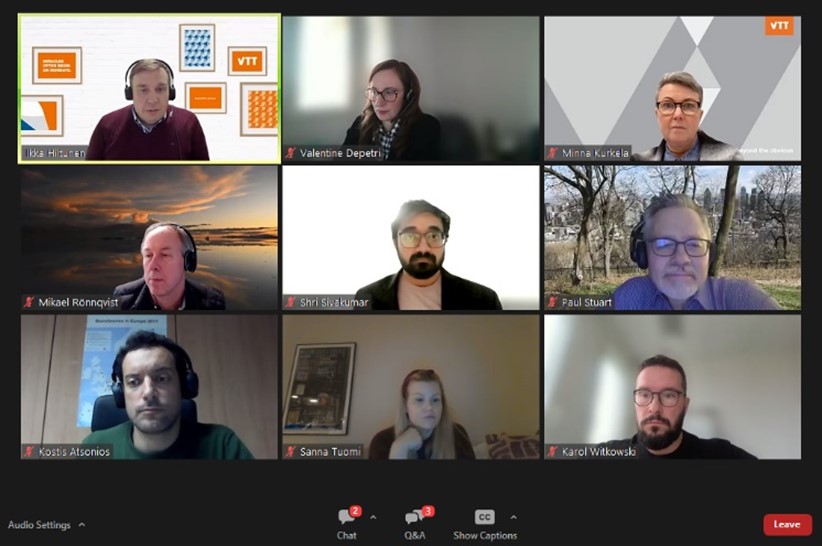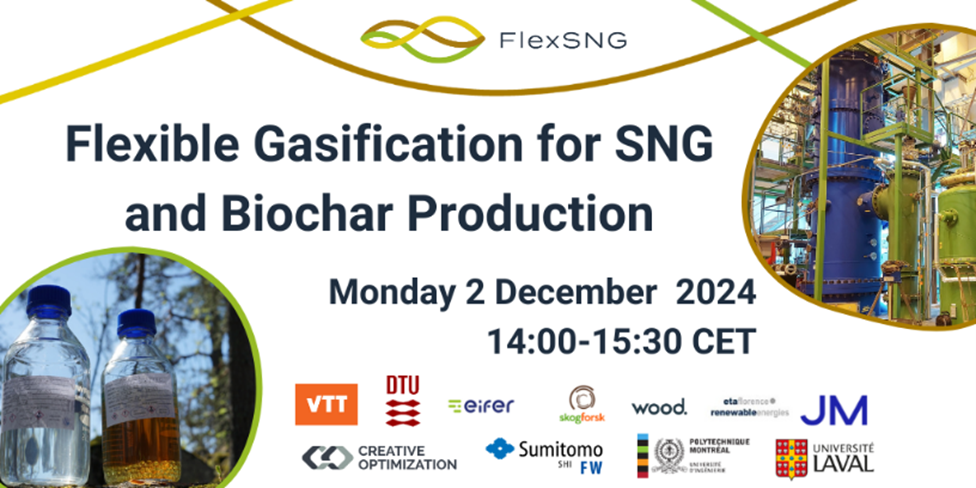FlexSNG Project Concludes with Breakthroughs in Clean Energy Innovation
The European FlexSNG project, in collaboration with the Canada’s Government, is concluding on December 31st, 2024, after 43 months of dedicated research and development. The project has successfully validated an innovative gasification process (TRL5[1]) capable of converting low-grade biomass residues and biogenic waste into biomethane, biochar and renewable heat. These technologies represent a significant step forward in global efforts toward decarbonization and the transition to a circular economy. FlexSNG’s achievements were showcased during a virtual Final Event on December 2nd, attended by over 230 participants from across the globe. The event highlighted the project’s flexibility in handling diverse feedstocks and its ability to adapt to different operational modes, paving the way for more sustainable energy systems. FlexSNG demonstrated its versatility by handling diverse feedstocks and supporting various operational modes, making it a promising solution for sustainable energy systems.

Introducing the webinar, the project coordinator, Minna Kurkela from VTT, provided an overview of FlexSNG’s goals and achievements. She highlighted the project’s innovative contributions to clean energy and its potential to support the transition to a circular economy. After that, Sanna Tuomi, VTT,presented the innovative gasification process at the heart of FlexSNG, which operates in two modes: co-production of biomethane, biochar and heat or maximizing biomethane output. She explained the achievement of TRL5 of biomass feedstock and the role of wood and biochar in addition enhancing stability and performance of waste gasification. The two gasifier designs – BCFB[2] for efficient tar decomposition and CFB[3] for greater flexibility – were evaluated, with CFB chosen for the project due to its uniform temperature profile and adaptability.
Ragnar Kiebach, DTU, explored the potential of oxygen transport membranes (OTM) as a cost-effective and efficient alternative for oxygen production in gasification. While OTMs improve syngas quality and process efficiency, challenges like clogging with waste-derived fuels remain. Ragnar emphasized that further optimization could unlock their potential to revolutionize biomass gasification economically.
Following, Karol Witkowski, EIFER,discussed biochar’s environmental and economic benefits, emphasizing its role in carbon sequestration (up to 3 tonnes CO₂ equivalent per tonne of biochar), soil fertility improvement and organic waste management. He highlighted its versatility in agriculture and energy, demonstrating biochar’s potential for long-term sustainable applications due to its chemical stability.
Erik Rönnqvist, CREAT,tackled the challenges of biomass logistics, such as geographic dispersion, seasonal variability and quality issues. He presented strategies for managing biomass from agricultural and forestry residues and industrial materials, emphasizing the importance of timing and location in processing. Key solutions included the use of flexible transport systems, pre-processing techniques to enhance feedstock quality and decision-support tools like Bioflow[4]. These strategies help to increase the efficiency and sustainability of the biomass supply chain, reducing environmental impacts and improving competitiveness.
From the Canadian team, Mikael Rönnqvist, from Université Laval, presented the analysis of biomass logistics and value chain optimization in Canada, leveraging advanced analytical tools to improve efficiency and reduce costs. Using datasets that included forestry residues, agricultural waste and municipal solid waste, combined with transport network data, he showcased how models like Bioflow and Woodflow[5] optimized flows, stocks and processing capacities. The analysis revealed over 20% cost reductions in logistics through optimized solutions, demonstrating the potential for significant improvements in operational efficiency. Paul Stuart, Polytechnique Montréal, focused on applying the FlexSNG process to Canadian case studies, particularly at Greenfield Global in Varennes, Québec. He explored nine configurations with varying biomass mixes – forest residues, agricultural residues and municipal solid waste – and production capacities. The findings highlighted that biomass availability in Canada exceeds that in Europe, while bioSNG costs are significantly lower. Advanced syngas cleaning reduced capital costs by over 30% and scenarios with limited government support showed internal rates of return (IRR) ranging from negative to 7%, emphasizing the economic viability of innovative configurations.
Then took the floor Kostis Atsonios, CERTH,presented a detailed analysis of the techno-economic feasibility and environmental impacts of the FlexSNG technology in Europe. Using case studies from Germany, Sweden and Greece, he evaluated three plant configurations based on local feedstocks such as biomass and urban waste. The study highlighted the efficiency of combining biochar and biomethane production, with carbon capture technologies playing a key role in reducing emissions, particularly in urban areas. Kostis concluded that large-scale FlexSNG plants could be economically competitive, with scalability being crucial to improving cost efficiency while maximizing environmental benefits.
Shri Sivakumara, Sumitomo SHI FW, focused on the design and scalability of the gasification island, detailing a 100 MWth biorefinery plant aimed at maximizing biomethane output. He described the two operational models: biorefinery mode (bark residues) and cityrefinery mode (urban waste). His work laid the foundation for the commercial deployment of FlexSNG technologies. Valentine Depetri, Wood,emphasized bioSNG as a key player in energy decarbonization, highlighting its compatibility with existing natural gas networks. She explained the methanation process, which converts renewable hydrogen and CO₂ into methane using advanced technologies like VESTA, known for its efficiency and scalability. The process supports the flexible production of clean energy, further advancing industrial decarbonization.
The FlexSNG project has successfully demonstrated innovative solutions for sustainable energy production, showcasing the feasibility of advanced gasification technologies and their integration into circular economy models. During the final webinar, participants actively engaged with the project team, posing questions that were addressed in the dedicated Q&A session, fostering insightful discussions. These achievements underline the project’s contribution to a cleaner and more resilient energy future. For more information about the project’s results and future applications, visit our official website or contact the project team. Watch the Video here.
About: FlexSNG is a Research and Innovation Action (RIA) that started on 1 June 2021 and will run for 43 months until 31 December 2024.
Contacts:
Sanna Tuomi (Project Coordinator – VTT): sanna.tuomi@vtt.fi
Laura Babusci (Communication and Dissemination Manager – ETA): laura.babusci@etaflorence.it
Project Partners:

Disclaimer: The content of this FlexSNG Press Release reflects only the authors’ view. The European Climate, Infrastructure and Environment Executive Agency (CINEA) & European Commission are not responsible for any use that may be made of the information contained or presented.

This project has received funding from the European Union’s Horizon 2020 Research and Innovation Programme under Grant Agreement No. 101022432 and the Government of Canada’s New Frontiers in Research Fund (NFRF) and the Fonds de recherche du Québec (FRQ).

[1] invented by NASA in the 1970s, has been adopted by other American and European bodies. It is based on a scale of values from 1 to 9 representing the different stages of development of a technology, in this case a technology validated in the relevant environment
[2] Bubbling Circulating Fluidised-Bed gasifier
[3] circulating fluidized bed
[4] It is an innovative tool designed to guide decision-making in global crop breeding.
[5] It is a two-sided online platform designed for wood importers and brazilian wood suppliers.


